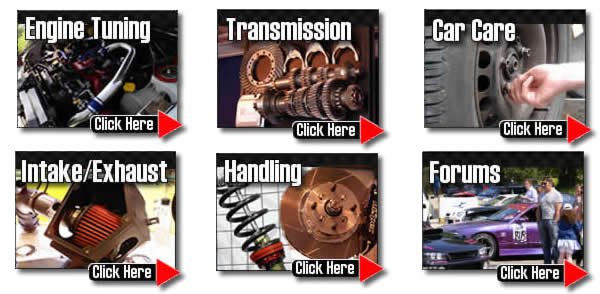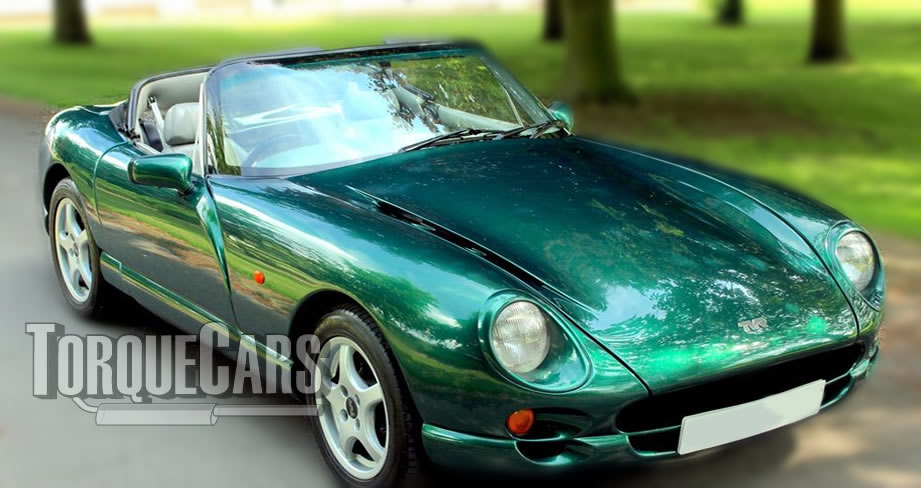TVR Chimaera Tuning
"Thanks for reading this TVR Chimaera tuning guide."
Produced from 1992 to 2003 the Chimaera has embarrassed many supercars on the track. An anecdotal story involved a Porsche club owner asking a TVR Chimaera driver to leave the track as he was showing up their cars.
The Chimaera is a good project car to do. The key to Chimaera tuning is finding the right mods - a lot of money can be wasted if you do it wrong.
TVR used the awesome tried and tested Rover V8 engines and in such a light chassis it makes for a storming car.
- 4.0 L Rover V8 240 bhp (179 kW; 243 PS) 270 lb⋅ft (366 N⋅m) at 4000 rpm
- 4.0 L Rover V8 HC 275 bhp (205 kW; 279 PS) 305 lb⋅ft (414 N⋅m)
- 4.3 L Rover V8 280 bhp (209 kW; 284 PS) 305 lb⋅ft (414 N⋅m) at 4000 rpm
- 4.5 L Rover V8 285 bhp (213 kW; 289 PS) 310 lb⋅ft (420 N⋅m)
- 5.0 L Rover V8 (Chimaera 500 models only) 340 bhp (254 kW; 345 PS) 320 lb⋅ft (434 N⋅m)

Handling/Suspension upgrades
Improving the handling for car owners first priority in your Chimaera tuning project.
Good suspension tweaks that greatly benefit handling for the Chimaera include a couple of degrees negative camber and 1-1.5 degrees of toe out on the front wheels.
We would go to a maximum drop of 22mm - 35 mm on most models. You risk compromising your handling if you go lower than this.
Our aim in engine tuning should be to increase peak power and torque at the top end.
The best power gains come from larger engine sizes. The more you start with the bigger the return on investment so engine swaps are good value mods for small engined cars.
Tuning modifications.
These are the sports upgrades are usually carried out by our members, decide how far you wish to go in your tuning project before you get started.
Getting the right motorsport upgrades for your planned usage of the car is vital. Stage 3 competition upgrades just don't work well on the road hard to control in slow traffic.
Please watch our introduction Video tutorial to car tuning. Be sure to subscribe and support our new channel.
How to tune your car
- Improve the handling
Focus on Suspension improvements, such as coilovers and make sure the bushings are in good order and that the alignment is correct. Then focus on improving the brakes, with a big disk brake conversion kit and fast road brake pads.
- Remove restrictions
Focus on the intake and exhaust with filters being the common point of restriction in a tuned car. Intercoolers may also become restrictive on turbo engines so this may also need to be uprated.
- Burn more fuel & air
Increase the fuelling so it matches the air coming into the engine. The ratio is important so you need to improve the fuel pump and injectors, so the head mods, big valve conversions, fast road camshafts and forced induction upgrades extra supply of air is adequately met.
- Test and replace any weak parts
Weak areas are commonly the clutch, the turbocharger and pistons and crankshaft in a highly tuned engine. Makes sure these components will cope with your power aspirations.
- The Tune or Remap
A cars ECU controls the fuel, timing, spark and even the turbo in some cases, so to fully extract your gains you should remap the car last and this will fully release the power. Some cars are easy to map, and others require piggyback ECU's or aftermarket ECU's but this is the most vital step of your tuning project.
Modifying to Stage 1:
Panel air filter, Sports exhaust, Remap, Alloy wheels, Suspension upgrade (drop 22-35mm), Lighter flywheel.
Modifying to Stage 2:
fuel pump upgrades, Fast road cam, high flow fuel injector, Power/Sport clutch, Ported and polished head.
Modifying to Stage 3:
Sports gearbox, Competition cam, Adding or upgrading forced induction (turbo/supercharger), Internal engine upgrades (pistons/head/valves), Engine balancing.
Peak power is nice in motorsport but for a drivable and fun car you need a long torque band and perhaps extending the rev range.

The aim of our advice is to give a limited introduction of modding upgrades and point you in the right direction, our forum is best place to go if you need more detailed advice and tips on your modified car project, the best modified parts and all aspects of modding cars.One of the biggest mechanical modifications you can do to your NASP engine is to fit a fast road cam .
The intake and exhaust durations play a large part in your cars power band, but be careful here, getting this wrong can upset the idle and make the car impossible to drive in traffic. You'd need to follow a camshaft upgrade with other mods and finish with a reflashed ECU to fully release the power gain.
Don't forget to look at the fuelling when you are increasing the power - it makes the car more thirsty.
If you find you get flat spots and power surges after your tuning upgrades you should check the fuelling and try a higher octane fuel as well. Improving the injectors is another beneficial modification and will deliver sufficient fuel.
A fuel pump will only deliver a finite amount of fuel, so you may need to uprate this if your injectors are demanding more fuel.
Intake and Exhaust Tuning.
Now we move on to the intake and exhaust and ensure proper flow through the engine. Induction kits only help to boost performance if your air intake is restricted! Adding an induction kit to most low power engines will see NONE OF A LOW END POWER GAIN AT ALL. If you have heavily modified your engine and it's need for air INCREASES DRAMATICALLY then an induction kit is the answer and will help remove this restriction.
For most Chimaera engines TorqueCars would suggest you just go with a washable panel air filter. On heavily tuned engines and turbo vehicles an induction kit will help release the power providing you address the problem of needing cold air.
Do not go with the biggest exhaust you can buy this will slow up the exhaust flow rate - the best exhausts for power gains are usually between 1.5 to 2.5 inches. It is the shape and material more than the bore size.
Getting the cylinder head flowed (ported and polished) will further help more air into each cylinder. This is definitely a job for a pro with a flow bench. A good heavy duty fast road upgraded clutch will help to keep that power going where it should. Never skimp or expect your standard OEM clutch to cope.
The best mods that we recommend for your Chimaera are Remapping or piggy back ecu, fast road cam and air intake and exhaust
NASP engines do not achieve big power gains if you remap them, unless you have done extensive modifications. With turbocharged engines this is another story. A remapped turbo will give impressive power gains and fully release the potential power of the engine.
The most significant power gains for NASP engines usually involve the addition of forced induction. It is generally easier to add a supercharger than it is to bolt on a turbo. It is harder to map a turbo as the boost increases exponentially with rpm.
Superchargers, however will give a boost which is proportional to engine speed so is simpler. Decreasing the engines compression ratio will allow you to add forced induction, water injection may also help prevent detonation.
Alloy wheel upgrades.
Alloy wheels can help the brakes cool down and are generally less heavy than the steel ones. Pay attention to your choice of tyres (tires) for your car, a good directional tread pattern tire can really enhance your cars handling. Large Chimaera alloy wheels can decrease performance. If you get big alloy wheels you will be changing your final drive ratio.
Although some people have fitted larger wheels without problems we would restrict ourselves to a 16 inch rim size as the maximum.
For more information on Tuning your car please join us in our friendly forum where you can discuss Chimaera options in more detail with our Chimaera owners. It would also be worth reading our unbiased TVR tuning articles to get a full grasp of the benefits and drawbacks of each modification.
Please help us improve these tips by sending us your feedback in the comments box below. We love to hear what our visitors have got up to and which mods work best for them on each model of car. Comments are used to improve the accuracy of these articles which are continually updated.
If you liked this page please share it with your friends, drop a link to it in your favourite forum or use the bookmarking options to save it to your social media profile.
Check out TorqueCars new YouTube channel, and see their awesome new content...
Feedback
Please use our forums if you wish to ask a tuning question, and please note we do not sell parts or services, we are just an online magazine.
Help us improve, leave a suggestion or tip
